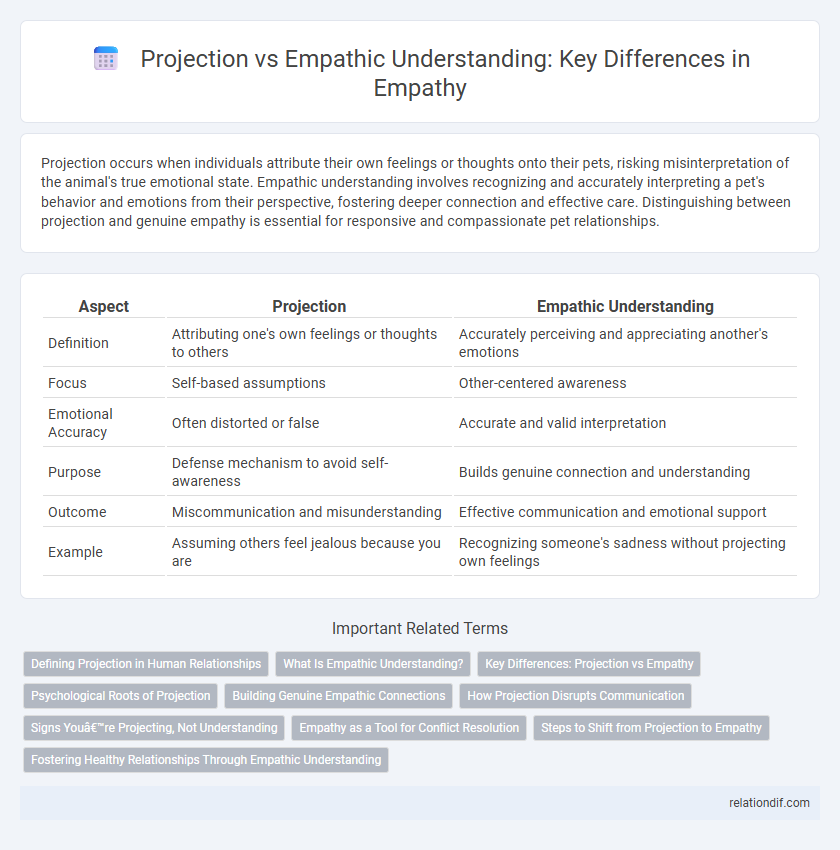Projection occurs when individuals attribute their own feelings or thoughts onto their pets, risking misinterpretation of the animal's true emotional state. Empathic understanding involves recognizing and accurately interpreting a pet's behavior and emotions from their perspective, fostering deeper connection and effective care. Distinguishing between projection and genuine empathy is essential for responsive and compassionate pet relationships.
Table of Comparison
| Aspect | Projection | Empathic Understanding |
|---|---|---|
| Definition | Attributing one's own feelings or thoughts to others | Accurately perceiving and appreciating another's emotions |
| Focus | Self-based assumptions | Other-centered awareness |
| Emotional Accuracy | Often distorted or false | Accurate and valid interpretation |
| Purpose | Defense mechanism to avoid self-awareness | Builds genuine connection and understanding |
| Outcome | Miscommunication and misunderstanding | Effective communication and emotional support |
| Example | Assuming others feel jealous because you are | Recognizing someone's sadness without projecting own feelings |
Defining Projection in Human Relationships
Projection in human relationships occurs when individuals attribute their own feelings, thoughts, or motives onto others, often unconsciously distorting reality. This psychological defense mechanism hinders true empathic understanding, as it replaces genuine perception with biased assumptions. Recognizing projection is crucial for developing authentic empathy and improving interpersonal connections.
What Is Empathic Understanding?
Empathic understanding involves deeply perceiving and resonating with another person's emotions and experiences without imposing one's own feelings or interpretations. Unlike projection, where individuals attribute their own emotions onto others, empathic understanding requires active listening and genuine emotional engagement to accurately grasp another's internal perspective. This ability enhances interpersonal connections by validating the other person's experiences rather than distorting them through personal biases.
Key Differences: Projection vs Empathy
Projection involves attributing one's own emotions or motives onto others, often leading to misunderstanding their true feelings. Empathic understanding requires accurately perceiving and resonating with another person's emotional state without imposing personal biases. Key differences lie in projection's self-centered distortions versus empathy's genuine recognition of others' experiences.
Psychological Roots of Projection
Projection originates from an unconscious defense mechanism in psychology where individuals attribute their own unacceptable feelings or impulses onto others, often to avoid internal conflict or guilt. This contrasts with empathic understanding, which involves consciously perceiving and relating to another person's emotions without distortion. Recognizing the psychological roots of projection is essential for developing true empathy, as it allows individuals to differentiate between their own unresolved issues and the authentic experiences of others.
Building Genuine Empathic Connections
Building genuine empathic connections involves moving beyond projection, which imposes one's own feelings onto others, and instead practicing empathic understanding that accurately recognizes and respects the unique emotions and perspectives of another person. This distinction fosters deeper trust and emotional safety, creating an authentic space where individuals feel truly heard and valued. Neuroscientific studies highlight that empathic engagement activates brain regions associated with emotional regulation and social bonding, underscoring its critical role in meaningful human connection.
How Projection Disrupts Communication
Projection disrupts communication by causing individuals to attribute their own feelings, thoughts, or motives onto others, leading to misinterpretations and defensive reactions. This distortion impairs genuine empathic understanding, as it replaces accurate perception with biased assumptions. Effective communication requires recognizing and suspending projection to foster true emotional connection and mutual insight.
Signs You’re Projecting, Not Understanding
Signs you're projecting rather than practicing empathic understanding include assuming others share your feelings or thoughts without validation, frequently misinterpreting their actions based on your personal experiences, and reacting defensively to their emotions. Projection often involves attributing your unresolved issues onto others, while empathic understanding requires actively listening and seeking to comprehend their perspective authentically. Recognizing these signs helps cultivate genuine empathy and improve interpersonal communication.
Empathy as a Tool for Conflict Resolution
Empathy as a tool for conflict resolution requires distinguishing between projection and empathic understanding; projection involves attributing one's feelings onto others, which can distort perceptions and escalate conflicts. Empathic understanding entails genuinely recognizing and validating the emotions and perspectives of others without bias, fostering trust and openness. This authentic emotional connection enables effective communication and paves the way for collaborative problem-solving in contentious situations.
Steps to Shift from Projection to Empathy
Recognizing personal biases and emotional triggers forms the foundation for shifting from projection to empathic understanding. Active listening without judgment allows individuals to appreciate the other person's perspective authentically. Practicing mindfulness and reflective self-awareness helps in distinguishing one's own feelings from those of others, deepening genuine empathetic connections.
Fostering Healthy Relationships Through Empathic Understanding
Fostering healthy relationships through empathic understanding involves accurately perceiving and respecting others' emotions without imposing personal feelings, which distinguishes it from projection where one unconsciously attributes their emotions onto others. Empathic understanding enhances emotional connection and trust by validating the experiences of others, promoting open communication. This approach reduces conflicts and deepens relational bonds by encouraging genuine empathy rather than assumed feelings.
Projection vs Empathic understanding Infographic

 relationdif.com
relationdif.com